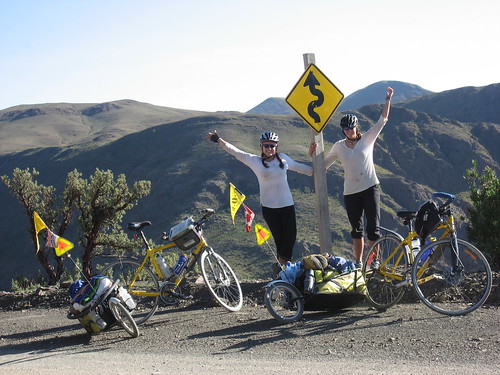Issik Kul is like the Saskatchewan of Kyrgyzstan. In a country that is over 90% mountainous, the shores of this huge lake are the flatlands. Fortunately for the cyclist (for whom flat often equates to boring), this is also the most fertile region and thus the most heavily populated and so a great place to take in some Kyrgyz culture....
In each of the small town and villages that we passed through on the highway between Bishkek and Karakol, small children came running to the roadside to wave and hollar, "hello!" and sometimes "how are you?" as we rode by. The adults were more reserved; some waved and said hello, others would wait until we initiated some sort of interaction, be it a wave or a nod, and then smiled broadly as they returned the greeting. Many people called out, "asgooda?", meaning, "where are you from?" as we pedalled past. A few stopped to chat when we took breaks or stopped at a small shop; all were eager to know where we were from, how far we had ridden and where we were headed. These converstations all took place through an exciting combination of rough english, kyrgyz and sign language and even when they were brief, were beautiful little cultural exchanges. A strange thing that we've noticed is that everyone we meet wants to give us their address and phone number and wants ours in return, even when we cannot speak the same language!
The highway so far has been paved, but 'pavement' means different things in different places and it hasn't always been the smooth black top that is so easy to cruise along. I tried to think of the best way to describe it as we rode along, and this is all I came up with.... You know that trick that you do for little kids, putting a finger horizontally between your lips and wagging it up and down while trying to speak so that the words come out all garbled?! Well, that's what some Kyrgyz asphalt feels like!!
The highways here are shared by belching soviet transport trucks, shiny new BMWs and Mercedes, childern on bicycles far too big for them, terminally ill Ladas and donkey-and horse-drawn carts. Herds of sheep, horses and cows cross frequently, driven by herders on horseback. The contrasts are incredible. One day we even saw a young man steering an old wooden horse drawn cart pull his horse to a halt so that he could answer his cell phone! Acutally, it seems like we're the only people in this entire country without cell phones, which really puzzles the locals who are constanly asking for our number or for us to call them.
The typical rural home here is made of cement or mudbricks, but finished on the outside and painted white, almost always with blue trim (we've seen one house with pink trim, otherwise all blue!) around the windows. The nicer homes are more ornate around the windows, with fancy shutters or glittery mirrors as decoration. The apexes are often done in wood and is the most aesthetic part of the home. There is usually a small door leading to a balcony and the wood is usually quite decorative. Each home has several small out-buildings (kitchens, tool sheds, etc.) and is surrounded by a fence which also includes a courtyard where most of the day's work and chores take place: this time of year, there is corn drying, potatoes and apples waiting to be taken to the market, laundry hanging, hay piled up for the winter, childen playing, etc. Apples and pears are both in peak season right now and there are buckets-full of each outside just about every home. We've been indulging in these often and they're delicious!!
Every day, we ride past a million and one incredible photo opportunities of people going about their daily business, but we try to be discreet and take photos only when appropriate. I hope that our picures will help to fill in any gaps and do better justice to this wonderful place than I can with words....
Christine
Wednesday, October 01, 2008
Subscribe to:
Post Comments (Atom)

No comments:
Post a Comment